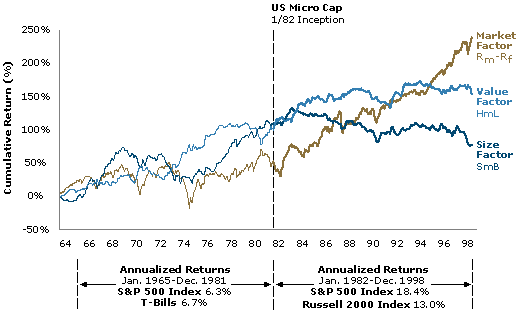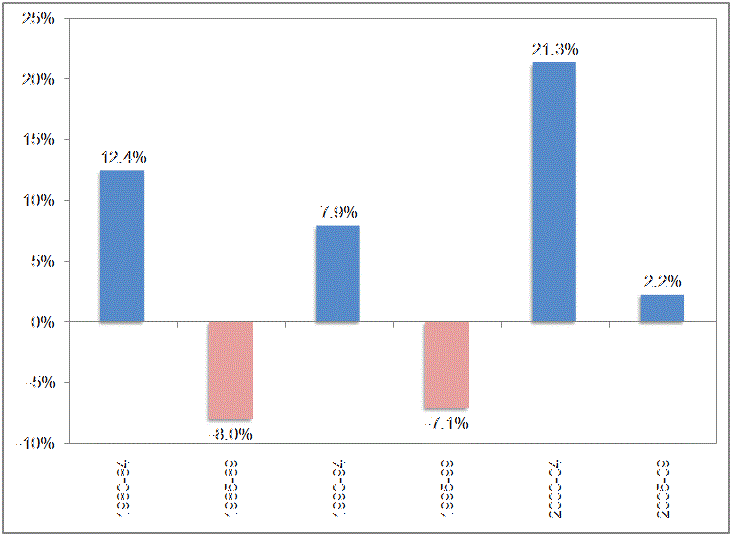Fama and French Three Factor Model for Stock Investing
Post on: 16 Март, 2015 No Comment

A logical investor might assume that the best performing stocks are massive, cash-rich companies that have been in existence for decades. A reasoning mind tells us that smaller companies (i.e. small and micro-cap stocks ) present a higher risk with less padding to fall on during economic crises. Others might argue that small stocks might be a suitable investment, but only if they are high-growth companies that are aggressively increasing net profits annually. But most might agree that small companies with low growth potential that trade close to their intrinsic value do not present valuable investments.
But does historical and empirical data back up this intuitive response or does it lead us in another direction? The answer is somewhat surprising, and the research behind the answer brings us to the Three Factor Model.
Two Brilliant Professors that Shocked the World
In the 1990s, Eugene Fama, the father of the efficient market hypothesis. and Kenneth French, an economics expert in his own right, began their research together which would eventually shake the investment world.
Fama and French sought to explain the relationships between the size of stocks and the net asset value of a company with its future performance. One of their most prominent findings was that the Capital Asset Pricing Model, which stated that beta (the degree of correlation and leverage a stock has to the market) adequately explains future stock returns, could only explain 70% of a share prices movement.
To close the gap, Fama and French came up with two additional factors as part of their Three Factor Model, which could effectively predict 90% of the movement in a companys share price, with the remaining 10% of share price movement referred to as alpha. For more information, see the research paper, Size, Value, and Momentum in International Stock Returns by Eugene F. Fama and Kenneth R. French (April 2011).
What exactly did the research of Fama and French uncover, and what does it mean for your stock portfolio today?
The Fama and French Three Factor Model
Factor 1: The Stock Market
Are stocks worthwhile investments? Fama and French compared stocks against the one-month U.S. Treasury bill rate, which is viewed as a safe investment. for the years 1991-2010. If the global stock market could not exceed these rates, buying publicly traded shares would not be a prudent decision in view of the higher risk. They found that global equities returned excess gains of 0.43% per month above and beyond the T-bill rate on average. Asia Pacific had 0.86% monthly excess gains. Clearly stocks were shown to be a good investment when compared to a risk-free benchmark.
Factor 2: Small Stocks vs. Big Stocks
Next, Fama and French attempted to analyze which class of stocks represented the best investment. They began by comparing small stocks to big stocks based on market capitalization. They found that there wasnt a significant difference in excess gains between 1991-2010. This research suggested that small stocks do not outperform large stocks when looking at broad averages. But dont count out tiny stocks just yet; there is more surprising data to come.
Factor 3. Value Stocks vs. Growth Stocks
Fama and French then compared value to growth stocks by examining companies with low price-to-book ratios (i.e. value stocks) to companies with high price-to-book ratios (i.e. growth stocks). Interestingly, on average, value stocks outperformed growth stocks during 1991-2010 by 0.46% per month. Thus, the research showed that value stocks provided greater potential returns than growth stocks.
Combining All 3 Factors: Small + Value + Market
So far, weve established that stocks provide excess returns over risk-free alternatives, small stocks do not provide excess returns over big stocks, and value stocks boast higher returns than growth stocks. Fama and French then went on to establish if there was a subset of value stocks that represented the best investment opportunity. Specifically, how would small value stocks compare to large value stocks?

This is where the study gets rather interesting. While the average value stock delivers returns 0.46% higher than growth stocks, further research shows that small value stocks perform much better than large value stocks. In fact, small value stocks provide excess returns over growth stocks to the tune of 0.67% monthly, while large value stocks only beat the average growth stock by 0.25% monthly. Therefore, small value companies beat large value stocks by 0.42% per month!
When all three factors are combined (small + value + stocks), Fama and French were able to adequately explain 90% of a share price movement.
Adding Small Value Stocks to Your Portfolio
Now that we have a grasp of the research behind why small value stocks represent such a great investment, what should investors look for when picking these stocks?
- Low price-to-book ratio. A price-to-book value under 1.5 is a good start. This means that share price will be no more than 50% higher than the net asset value of the company. A strict screen would have price-to-book less than one.
- Less than $2 billion market cap. The upper threshold on a small-cap stock is two billion dollars. Ideally, if you can find a company below $1 billion, the chances that it is undervalued are even greater.
- U.S. stocks . You may limit your search to American companies to lower your investment risk in light of the looser laws and fraud allegations in other countries like China.
In addition, you can combine these criteria with other well-known strategies like those of Warren Buffett or Joseph Piotroski. Here are a few trading ideas to further refine your small value stock list:
- Select companies with high net insider or institutional buying.
- Buy high momentum stocks in certain countries such as the U.S.
- Narrow your selection to hot sectors or industry groups in favor.
- Pick stocks with future earnings forecasts greater than 10%.
- Look for a steady, historical increase in sales to complement earnings growth.
Final Word
I am not suggesting that you ditch your shares of Apple just because its a big growth stock, or that you should shun companies based on size and growth. However, by adding small cap stocks with low price-to-book value, you will be able to broadly increase your chances of having investments that will significantly and dependably outperform their peers. With that said, as with most investment categories, small value stocks should only make up a percentage of your personal portfolio asset allocation based on your risk appetite and age.














